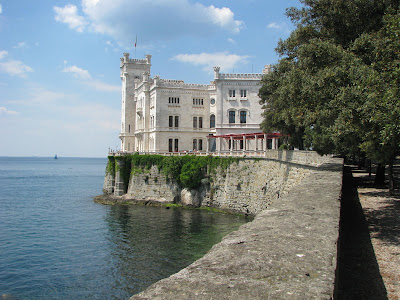A few weeks ago we traveled to Trieste, stopping at Caste Duino on the way. (see prior posting.) There was another castle, Miramare, which we did not have time to see that day, so on Saturday that’s where we headed. Trieste lies around the curve of the Adriatic, close to Slovenia. It’s a wonderful old-world city, and worthy of a day of exploration of its own. It has seen many changes, especially in the last century, under different governments. It has always been valued for its port, and you can see the different types of vessels there are – pleasure craft, barges, tankers, etc.




Just as you enter Trieste, you find Miramare, a rather “new” castle, as castles go here in Italy, one access being through this imposing gate.

The whiteness of it stands in stark contrast to the blue sky and that distinctive color of green-blue that is the Adriatic Sea.


Miramare and its surrounding park was the castle of Maximilian of Hapsburg and his wife, Charlotte of Belgium. Max, as he was known, was the younger brother of Franz Joseph, who achieved supreme royal status of the Austrian Empire. As was common, the younger brother pursued a military career; in this case Max joined the Austrian fleet. Unlike his brother, he was an extremely sensitive man, observant of nature, an appreciator of culture and art. During his early naval career, he traveled to Greece, Turkey, Spain, Portugal, Sicily, and throughout the Adriatic, thus becoming familiar with Trieste, which he eventually chose as his residence in 1854. It was his exposure to architecture of these places that he drew upon as inspiration for the castle and park at Miramare. And it was Max who was responsible for the details of the castle and park, both inside and out. Construction began in March, 1856, Charlotte and Max became engaged on December 31 of that year, and they were married the following July. The castle did not become habitable until Christmas 1860, so the couple, when not living elsewhere due to Max’s duties, lived in the Castello, or little castle, during the building of Miramare.


This is the entrance to the castle

And around to the side where steps descend to a sunken garden.


If you continue around to the back, the side facing the sea, these are shots taken from there.







Looking down on Miramare’s private boat marina.


Notice in the last picture the sphinx perched at the end of the pier.

Here is a picture of the castle and marina taken from further along the path that skirts the sea coast


Detail of statue on tower

A peek of the castle, from an opening along the path

Opposite the front of the castle, behind the entrance courtyard, a pergola of wisteria surrounds the courtyard where the natural area of the park climbs the hill behind it.




Beside the courtyard, and surrounded on the left and to the rear by the natural area, was the formal parterre garden.




The natural area was originally planted with trees and shrubs that Max had seen on his trips, however, not all were suited to this harsh wind-swept environment.

There was a pond where you could see swans and ducks

and turtles playing “leap frog”, or would that be “leap turtle?” Or maybe they were playing king of the hill.

We had a bit of refreshment at the café and David made a friend when he gave this cat a bite to eat.

As was typical, there were statues tucked in various places




One poignant statue is of Max when he was appointed Emperor of Mexico.


As usual, we were not allowed to take interior pictures, so these are photographed from the guidebook to Miramare.
A picture of Max and Charlotte

Their wedding picture

Charlotte’s bedroom

Page 20 Charlotte’s dressing room

Max’s room made to look like a cabin aboard his ship, Navarro

The library

Main staircase

At the top of the staircase. Notice the fountain in the floor: it was filled with water and fish and was translucent so that you could look down into the foyer below.

The Wind Rose Room. Notice the compass on the ceiling. It was attached to a flag on the roof so that you could tell which direction the wind was blowing from inside.

Chinese drawing room

Japanese Drawing room

Max’s political career was one of disappointment. When he was nominated by his brother to be governor with civil powers of Lombardy-Veneto in the spring of 1857, he never became accepted by the populace because of his political differences. He soon retired from that position to live in the Castletto while Miramare was being built. In 1861 Napoleon III presented Max with the opportunity of accepting the Crown to Mexico. With the promised military and financial support from Pope Pius IX, Napoleon III, and his father-in-law, Leopold I, king of Belgium, Max renounced his claim to the Austrian crown and the couple set sail for Mexico. These promises did not come to fruition and the Mexican people did not accept Max. As a result, Charlotte returned to Europe in 1866 to see help. In June 1867, Max, aged 35, was killed by a firing squad. His body was returned to Vienna in 1868. Charlotte had begun to show signs of mental instability on her return to Europe and was confined to the Castletto, eventually taken to Belgium, where she died in 1927, aged 87.
Despite these tragic endings, I like to think of this couple as happy, Max writing, reading or planning further improvement to Miramare; Charlotte playing her piano, painting, or doing needlework, for she was quite an accomplished artist in all three disciplines; surrounded by the beauty of Miramare, if only for a short time.